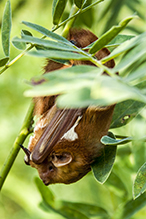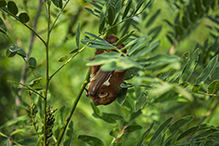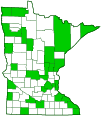Eastern Red Bat
(Lasiurus borealis)
Conservation • Description • Habitat • Ecology • Distribution • Taxonomy
Conservation Status |
|||
| IUCN Red List | LC - Least Concern |
||
| NatureServe | N5 - Secure SNR - Unranked |
||
| Minnesota | Species in Greatest Conservation Need |
||
Description
Eastern Red Bat is a medium-sized, solitary, migratory, tree bat. Adults are densely furred, 3¾″″ to 4⅝″ long, and weigh ¼ to ½ ounce.
The fur (pelage) of the male is brick red. The stiff, long hairs (guard hairs) are white-tipped, giving the fur a frosted appearance. There is a buffy white patch on the front of each shoulder. On females the pelage is often described as yellowish-red but might be more accurately described as dull, buffy, chestnut brown. Unlike most bats, the female has four mammary glands.
The forearm is 17 ⁄16″ to 1⅝″ long.
The wing-like flight membrane (patagium) is composed of skin and associated tissues between the neck and the first digit of the forelimb (propatagium), between the digits of the forelimb (dactylopatagium), between the last digit and the hind limb (plagiopatagium), and between the tail and the hindlimb (uropatagium or interfemoral membrane). The upper side of the interfemoral membrane is densely and completely covered with fur. The underside is thinly furry and just near the base. The patagium is otherwise naked except for thin fur along the humerus and at the wrist.
The tail is relatively long, 1¾″ to 27 ⁄16″, but does not extend beyond the interfemoral membrane. It is hairy on the upper surface. The genus name Lasiurus means “hairy tail”. When in flight the tail and interfemoral membrane are held outstretched, giving a distinctive V-shaped silhouette.
The foot is small, about half the length of the uppermost tarsal bone.
The skull is short and blunt. The ear is short, broad, and rounded. It is not rimmed with black. The projection covering the ear canal (tragus) is triangular and relatively short, about ⅛″ long. It is naked on the inner surface and densely furry on the basal two-thirds of the outer surface. The mouth has 32 teeth. There is a single upper incisor on each side. The first molar-like tooth is tiny and peg-like. It is on the inside (tongue side) of the canine tooth.
Size
Total length: 3¾″″ to 4⅝″
Wingspan: 11½″ to 13″
Tail: 1⅝″ to 2″
Sign
Similar Species
Hoary Bat (Lasiurus cinereus) is larger, up to to 5¾″ long. The pelage is brown. The hairs above are strongly white-tipped, giving the bat a hoary appearance.
Silver-haired Bat (Lasionycteris noctivagans) pelage is black or dark brown with silvery tips. The upper surface of the interfemoral membrane is lightly furred. The ears are hairless.
Habitat
Woodland openings and edges, hedgerows, tree-lined roads, streams.
Ecology
Behavior
During the day they hang by their feet in in a tree or shrub usually 2′ to 10′ off the ground. They choose a sight with dense foliage above and to the sides but clear below, leaving a clear flight path. They have a single feeding session each day lasting a few hours. They usually begin hunting at dusk, but sometimes later in the night. They locate their prey both by echolocation and by sight. They migrate south in the winter but their wintering range is unknown.
Lifespan
About 12 years
Life Cycle
Males and females have different summer ranges. Though solitary, they come together to migrate in mixed sex flocks of up to several hundred individuals. Mating takes place in August and September during southward migration. The female stores the sperm over the winter, and fertilization occurs the following spring around March and April. After about 90 days she gives birth to usually two or three but up to five young. The young are suckled for about 38 days and take their first flight after about 5 weeks. Those that reach adulthood live about 12 years.
Food
Mostly moths, but also beetles, flies, and other insects.
Disease Vector
Bats are important vectors of the rabies virus but rabid bats pose little threat to humans. They are passive, will not attack, and will not bite unless handled.
Distribution |
||
|
Sources Biodiversity occurrence data published by: Minnesota Biodiversity Atlas (accessed through the Minnesota Biodiversity Atlas Portal, bellatlas.umn.edu, 12/11/2025). Timm, R. M. 1975. Distribution, natural history, and parasites of mammals of Cook County, Minnesota. Occasional Papers, Bell Museum of Natural History, University of Minnesota 14:1–56. Hazard, Evan B. 1982. The Mammals of Minnesota. University of Minnesota Press, Minneapolis, Minnesota. 280 pp. |
|
| 12/11/2025 | ||
Occurrence |
||
Widespread but not common in Minnesota |
||
Taxonomy
Class
Subclass
Theria
Infraclass
Placentalia (Placental Mammals)
Magnorder
Boreoeutheria
Superorder
Laurasiatheria (Ungulates, Carnivorans, and Allies)
Order
Chiroptera (Bats)
Suborder
Yangochiroptera
Superfamily
Vespertilionoidea
Family
Vespertilionidae (Evening Bats)
Subfamily
Vespertilioninae (Vesper Bats)
Tribe
Lasiurini (Hairy-tailed Bats)
Genus
Lasiurus (Hairy-tailed Bats)
Subgenus
Lasiurus (Red Bats)
Subordinate Taxa
Prior to 1988 there were five subspecies of red bat (subgenus Lasiurus) recognized. Under this classification, only the Northern Red Bat (Lasiurus borealis borealis) was found in eastern and central North America. Two of the former subspecies have been raised to species status, three were transferred to subspecies of Western Red Bat (Lasiurus blossevillii). There are no subspecies of Eastern Red Bat currently recognized.
Synonyms
Atalapha borealis
Vespertilio borealis
Common Names
Eastern Red Bat
Red Bat
Glossary
Guard hair
A long, straight, coarse hair that projects beyond and lays over ground hairs; the two hair types, sometimes also with awn hairs, comprise the pelage in fur-bearing animals.
Interfemoral membrane
In some mammals, the part of the patagium that extends between the legs and the tail; uropatagium.
Patagium
In some mammals, the membrane between the forelimb and the abdomen that assists in flying or gliding. In Lepidoptera, one of a pair of hair-covered, sausage-shaped, scale-like plates on the thorax that cover the wing bases. Plural: patagia.
Pelage
The coat of a mammal, consisting of fur, wool, or hair, and including a soft undercoat and stiff guard hairs.
Tragus
The fleshy projection on the inner side of the outer ear partially covering the ear canal.
Visitor Photos
Share your photo of this mammal.
This button not working for you?
Simply email us at info@MinnesotaSeasons.com.
Attach one or more photos and, if you like, a caption.
|
|
|
MinnesotaSeasons.com Photos
Female roosting in a dense thicket of desert false indigo |
||
 |
 |
|
 |
||

Slideshows
Lasiurus borealis (Red Bat)
Allen Chartier

Visitor Videos
Share your video of this mammal.
This button not working for you?
Simply email us at info@MinnesotaSeasons.com.
Attach a video, a YouTube link, or a cloud storage link.
Other Videos
Red Bat (Lasiurus borealis) youngster gets a drink and a scratch on the back!
SCUBAdad2006
Eastern Red Bats - Mating
Gene Rollins
Morning Eastern Red Bat
Sthemingway
Peck Ranch Red Bats
CelestialWolven

Visitor Sightings
Report a sighting of this mammal.
This button not working for you?
Simply email us at info@MinnesotaSeasons.com.
Be sure to include a location.
Minnesota Seasons Sightings





